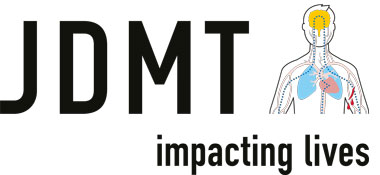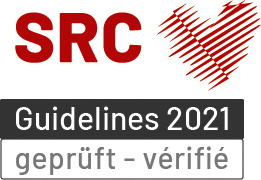Effective first aid in only 5 steps
First aid is not difficult. The approach, which JDMT has developed with the help from emergency physicians and rescue services, shows in five steps how to effectively provide First Aid.

Click on each Tab and discover how you can manage every emergency situation step by step.
Know how to manage emergencies thanks to a system
Situation, Safety, Support

Situation
- What is the Situation? Which forces have been at work?
- Minor incident or serious emergency?
- Several people affected? Complex circumstances?
Safety
- Are there risks for the first aiders, those affected or bystanders?
- What action has to be taken to ensure it?
- Cordoning the area of, removing oneself from the area, other action?
Support
- Is it already obvious, that support is required?
- Emergency services, fire brigade, other responders?
- If low-threshold consult by dialling the emergency number 144.
First impression

Get an overall idea of the patient’s condition within a few seconds:
- Is the patient standing, sitting or lying down? Are his eyes open?
- Are they speaking, can they provide information, do they appear confused?
- Are they in pain, do they have obvious injuries? Are they bleeding?
- Does their respiration seem normal? Does their skin/ skin colour look normal?
Patient assessment

Systematically assess the patient’s condition:
Consciousness > Respiration > Circulation > Injuries
Always ask yourself the question whether what you are assessing is okay or not. If something is not okay, then this must be defined as a “cause for concern”. Concequence: this aspect must be discussed with a medical expert.
- Is the person fully conscious? Or do they seem confused or are they even unconscious?
- Does their respiration seem normal? Or are they breathing rapidly or having trouble breathing?
- Can a whistling be heard when they breathe in and out?
- Are there any circulation problems (dizziness, generally feeling unwell, paleness, beads of perspiration) visible?
- Are there any injuries (misaligned extremities, swelling, bleeding) visible?
- Are internal injuries possible (internal bleeding, spinal injury)?
Realise, Decide, Organise

- Is the situation urgent? What is the main problem?
- Have you addressed what is wrong with the patient?
- Could they be having a heart attack? Do they have a spinal injury?
- The aim is to not miss anything serious.
- Decide how you want to proceed and organise everything that is required.
If a heart attack is assumed a deliberate decision should be made to proceed according to the heart attack approach. Even if the person concerned is not keen on this and would prefer to be left in peace.
Always consult a medical expert / or dial 144 if in doubt, even without the consent of the person concerned.
- What actions need to be taken in terms of organisation (guidance for emergency services, fetching the AED and first aid equipment)?
- Does the patient need to be prepared for resuscitation (AED, other responders outside the patient’s vision)?
- Calm must be ensured, do people have to be sent away?
Medical measures

You must be able to handle few measures:
- Alert & instruct
- Compressions
- Use of AED/defibrillator
- Manual inline stabilisation
- Heimlich Manoevre
- Stop bleeding
- Administer sugar
- Recovery position
- Seizure: support head
- Attend to wounds








